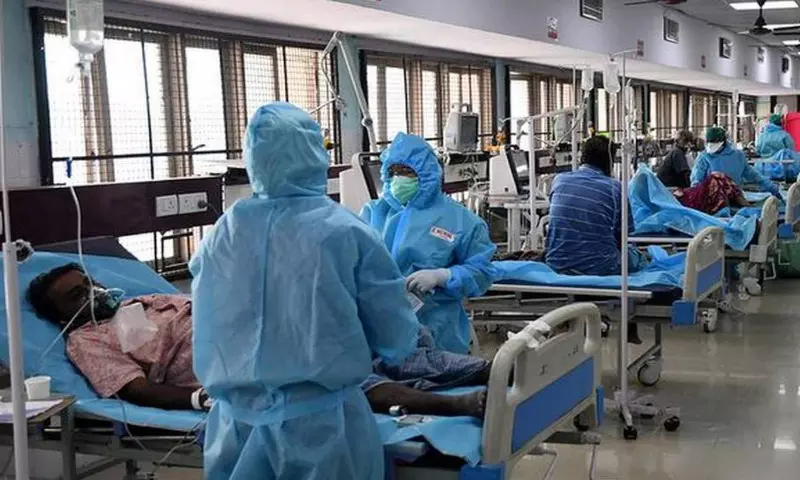Explained: What is 'Black Fungus', its symptoms; what COV-victors need to know
By Dr Ravi Andrews Published on 9 May 2021 1:45 PM GMT
"From the frying pan into the fire" is an old proverb. Today, many COV-victors, those who have fought and defeated COVID-19, find that they have gone from "the fire into the frying pan"! Even after recovering from COVID -19, a significant number are developing mucormycosis. This is a deadly fungal infection also known colloquially as the "black fungus" owing to the black fungal colonies it produces in the mouth and the nasal sinuses.
Mucor is a fungus that is present naturally in the environment, especially in the soil, plants and contaminated food. It can enter the human body via the nose and mouth through inhalation of its spores that are released into the atmosphere.
Under normal circumstances, mucor does not cause human infection because the normal immune system can easily destroy it. However, when the immune system is compromised for any reason like due to disease or medications, mucor can cause a devastating infection that spreads faster than a forest fire and kills more than half of its victims.
The infection often starts as a small ulcer in the mouth, or a stuffy or runny nose. There may also be a mild headache or red eyes. Within a few days the eyelids become puffy and droopy, facial muscles become weak and vision starts reducing. If left untreated, the patient can become drowsy and disoriented, develop brain strokes and even slip into a coma. Death soon follows.
The prototype of a patient suffering from mucormycosis is either a diabetic with uncontrolled sugars or a post-transplant patient on immunosuppressants or an HIV-positive patient or a cancer patient on chemotherapy. Nowadays, doctors are noticing a worrying trend where patients are recovering well from COVID-19 infections but two to three weeks later are developing mucormycosis.
They are emerging from the dark cloud of COVID -19, only to enter the darker cloud of mucormycosis (their dark cloud has a darker lining!). Even more frightening is the fact that many of these patients are young and do not have diabetes or any other immunosuppressive illness. Prior to 2019, before the COVID -19 era, most doctors would see just one or two cases of mucormycosis per year. In the post-COVID era, many doctors are seeing one or two cases every day!
There are many reasons as to why post-COVID patients are so vulnerable to mucormycosis:
1. Indiscriminate use of steroids for the treatment of COVID -19. This causes immune system suppression. Steroids worsen diabetes control among diabetics and can also precipitate diabetes among non-diabetics.
2. COVID-19 by itself has been known to precipitate diabetes in hitherto non-diabetic people.
3. Indiscriminate use of oxygen without taking the necessary precautions to ensure cleanliness. Usually oxygen is humidified with water before delivering it to the patient. If unclean water is used, it may contain mucor spores which enter the nostrils while giving oxygen. Ideally, only distilled water should be used to humidify oxygen before delivering it to the patient.
4. Indiscriminate use of other immunosuppressants like Tocilizumab or Itolizumab to treat COVID -19.
5. SARS-COV-2 virus is known to damage respiratory skin cells (called epithelium) to facilitate its entry into the lungs. There is a strong likelihood that the virus also damages nasal skin cells and this facilitates the entry of mucor into the nose.
6. Poor hygienic practices after COVID-19 infection.
Treatment of mucormycosis is very limited. Further, the treatment is effective only if started early. Surgery is the backbone of treatment where attempts are made to scrape out or remove as much of the fungus as possible (called debulking). Simultaneously, anti-fungal medications are given.
There are just three or four antifungals that are effective against mucor. All of these are toxic and expensive and will need to be given for at least 6- 8 weeks. Often a single sitting of surgery will not be enough and many patients require multiple surgeries to debulk the fungus. Sometimes the eyes or the jaws or the nose will have to be removed to limit the fungus. Once the fungus enters the brain, nothing can be done.
Since treatment is so limited, prevention is the best option to avoid this devastating post-COVID complication. Personal hygiene should be strictly maintained at all times. Gargles and nasal douching with betadine may help. Keep blood sugars under very tight control. Use steroids and other immunosuppressants judiciously and only under the supervision of a qualified COVID physician. Use only distilled water as a humidifier while delivering oxygen to the patient. Do not ignore early symptoms like oral ulcers, runny nose with bloody nasal discharge, persistent headaches, or mild decrease in vision.
Do not panic but be vigilant. If we are careless, we might be in the scary situation of - "Ashes to ashes, dust to dust. If COVID doesn't get you, Mucor must!"
